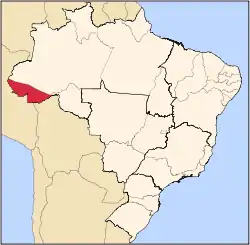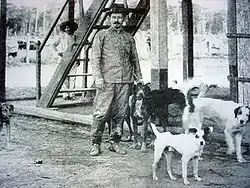Republic of Acre
The Republic of Acre (Portuguese: República do Acre, Spanish: República del Acre) or the Independent State of Acre (Portuguese: Estado Independente do Acre, Spanish: Estado Independiente del Acre) were the names of a series of separatist governments in then Bolivia's Acre region between 1899 and 1903. The region was eventually annexed by Brazil in 1903 and is now the State of Acre.
Republic of Acre República do Acre / República del Acre | |||||||||||
|---|---|---|---|---|---|---|---|---|---|---|---|
| July 1899 – March 1900 November 1900 – December 1900 January 1903 – November 1903 | |||||||||||
 Emblem
| |||||||||||
Motto: "Patria e Liberdade" | |||||||||||
 Location of Acre in present-day Brazil | |||||||||||
| Capital | Cidade do Acre | ||||||||||
| Common languages | Portuguese | ||||||||||
| Religion | Roman Catholicism | ||||||||||
| Government | Presidential republic | ||||||||||
| President | |||||||||||
• 1899–1900 | Luis Gálvez Rodrígues de Arias | ||||||||||
• 1903 | José Plácido de Castro | ||||||||||
| History | |||||||||||
• First Republic declared | July 14 1899 | ||||||||||
• Restored to Bolivia | 15 March 1900 | ||||||||||
• Second Republic declared | November 1900 | ||||||||||
• Second Republic suppressed | December 24, 1900 | ||||||||||
• Third Republic declared | January 27, 1903 | ||||||||||
• Treaty of Petrópolis | November 11 1903 | ||||||||||
| Area | |||||||||||
| 1900 | 191,000 km2 (74,000 sq mi) | ||||||||||
| Population | |||||||||||
• 1900 | 10000 | ||||||||||
| Currency | Réis | ||||||||||
| |||||||||||
| Today part of | |||||||||||
History

For forty years, after around 1860, Acre had been overrun by Brazilians, who made up the vast majority of the population.[1] The territory of Acre was assigned to Bolivia in 1867 by the Treaty of Ayacucho with Brazil. The rubber boom of the late 19th century attracted many Brazilian migrants to the region. In 1899–1900, the Spanish journalist and former diplomat Luis Gálvez Rodríguez de Arias led an expedition that sought to seize control of what is now Acre from Bolivia. The expedition was secretly financed by the Amazonas state government and aimed to incorporate Acre into Brazil after its independence from Bolivia. Gálvez declared himself president of the First Republic of Acre on July 14, 1899, and set up his capital at Puerto Alonso, which he renamed Cidade do Acre. That first republic lasted until March 1900, when the Brazilian government sent troops to arrest Gálvez and give Acre back to Bolivia. Gálvez was deported to Spain and the inhabitants of Acre found themselves up against both Bolivia and Brazil.
In November 1900 an attempt was made at creating a Second Acre Republic with Rodrigo de Carvalho as president. Again the movement was suppressed, and Acre remained part of Bolivia until 1903.

After the failure of the second attempt of Acre to secede from Bolivia, a veteran soldier from Rio Grande do Sul who had fought in the Federalist Revolution of 1893, José Plácido de Castro, was approached by the Acrean Revolution leaders and offered the opportunity to lead the independence movement against the Bolivians. Plácido, who had been working in Acre since 1899 as a chief surveyor of a surveying expedition and was about to go back to Rio de Janeiro, accepted the offer. He imposed strict military discipline and reorganized the revolutionary army, which reached 30,000 men. The Acrean army won battle after battle and on January 27, 1903, José Plácido de Castro declared the Third Republic of Acre. President Rodrigues Alves of Brazil ordered Brazilian troops into Northern Acre in order to replace Plácido as the president of Acre. Through Barão do Rio Branco's most able ministerial diplomacy, the question was settled. After negotiations, a treaty was signed. The Treaty of Petrópolis, which was signed on November 11, 1903, gave Brazil Acre (191.000 km2) in exchange for lands in Mato Grosso, payment of two million pounds sterling and an undertaking to construct the Madeira-Mamoré Railroad that would allow Bolivia access to the outside world. On February 25, 1904, it was officially made a federal territory of Brazil.

In popular culture
The Republic of Acre forms the background to Márcio Souza's 1976 novel Galvez – Imperador do Acre.
See also
References
- Weinstein, Barbara (1983). The Amazon Rubber Boom, 1850–1920. Stanford, CA: Stanford University Press. p. 205. ISBN 0-8047-1168-2.
- Scheina, Robert L. (2003). Latin America's Wars: The Age of the Caudillo, 1791–1899. Brassey's. pp. 7–9. ISBN 1-57488-452-2.
- "New Republic Founded: The Evolution of a South American No Man's Land," Philadelphia Inquirer, Nov 12, 1899, p 7
- "Acre Seeks Recognition: New South American Republic Sends a Minister to This Country," New York Times, Nov 24, 1900, p 1
- "Acre and Its Rubber: Cause of the Establishment of the New Republic," New York Times, Nov 25, 1900, p 12
- "A Short-Lived Republic: Acre, the Land of Rubber, No Longer a Separate Country," New York Times, Nov 30, 1900, p 1
- "Acre Belongs to Brazil: A Settlement of the 'Rubber Republic' Dispute," Kansas City Star, Aug 12, 1903, p 4

